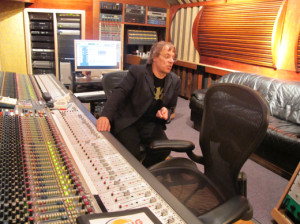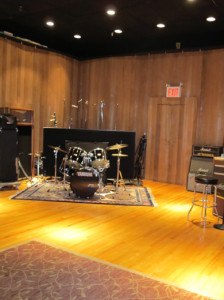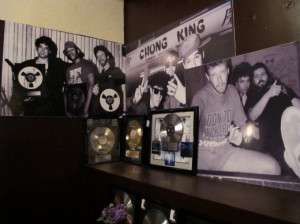Chung King Studios Closes — New Direction for Classic Rooms at 36 W. 37th Street
Chung King Studios has closed – again. And with John King’s exit from 36 West 37th Street, comes a new chapter for this coveted space.

John King has exited the Chung King Studios located he helmed for almost three years. (All photos by Janice Brown)
On Friday the 13th of February, King and his crew notched the last session at Chung King’s most recent location. The closure came one month shy of three years for the latest edition of Chung King, a location that followed King’s long-term occupation of 170 Varick Street, and the original Chinatown home of The Chung King House of Metal before that.
Although King is leaving behind a legendary Manhattan facility – the 5,000 sq. ft. space currently contains two studios and one of the most respected live rooms anywhere – he is at peace as he exits his latest sound salvo. “I’m moving out of the place, and I’m so happy I could die,” King said. “It’s the finest sounding studio I’ve ever worked on in my life. The problem is that the mentality of the music business has changed: People are not willing to pay the rates for a big room.
“The record companies have no money,” he continues. “I didn’t get a single record company PO in the last year. So the business wasn’t there to be able to pay the insurance, plus city/state/local taxes, and the landlord. It very quickly got to be about $25,000 a month to keep a room-and-a-half going.”
At Chung King’s first location, John King built his business– along with a controversial reputation as a driven but volatile audio guru — hosting the likes of Russell Simmons, Rick Rubin, the nascent Def Jam label, and budding artists like run DMC, the Beastie Boys, and LL Cool J. On Varick Street, his “Blue,” “Red,” “Green” and “Gold” rooms, outfitted with large format Neve and SSL consoles, was the recording home of everyone from Phish to Depeche Mode, Maxwell, Moby, Lil’ Wayne, Kanye West, and myriad more platinum.
But King admits that his loyal following became less dependable at the 37th Street location, despite its pedigree. “New York City is very difficult to do business in nowadays – it takes forever to drive equipment in and out, which is a pain in the ass,” King notes. “I did sessions for Fergie, Prince Royce, Busta Rhymes – all my old clients – but they came through for a day, not a month like they used to.”
When SonicScoop interviewed King in 2012 in an article on the launch of the 37th Street Chung King Studios, he expressed enthusiasm for focusing on just two rooms, as opposed to the two floor multi-suite facility he had overseen in Tribeca (“I wanted something more manageable.”). Following his experience uptown however, King now realizes that his optimism may have been misguided.
“You’re better off with the grocery store than you are with a bodega,” says King. “The one-room studio is more of a producer’s studio. It was too expensive for me to sit there and produce things, and it really got down to the point where people only had $150 to spend on something. So I was doing a lot of two- and three-hour sessions – it just wasn’t enough to pay the bills.
“The big difference was that at the larger (TriBeCa) studio I could design and produce, and I didn’t have to be there all the time. I had great people there taking care of the studio, and I didn’t have to be the day-to-day person. In this particular case, I had to take care of everything.”
A Swift Transition
The closing of Chung King does not mean the end of 36 W. 37th St. as a studio, however. Quite the contrary, the space is already spoken for: It will be taken over by Steve Salett, who founded DUMBO’s Saltlands studio complex in 2007, and plans to carry over the business model – in a rare reverse commute – from Brooklyn to Manhattan.
At Saltlands, Salett has honed a popular paradigm by renting a number of production suites to independent producers, alongside a separate commercial studio. “Saltlands has been a good way to work, because you create your own ecosystem – your own mini-economy,” Salett says. “It’s just naturally a more stable situation to work with a group of people, then it is in one single space. It’s a happier environment, where people want to come and work. Music is a collaborative art form, so this approach lends itself to that.”
According to Salett, Saltlands will continue to operate in DUMBO, and that location is expanding. While the new name of the 37th Street studios has not yet been determined, Salett expects to simulate his Brooklyn system there.
Meanwhile, he is totally tuned in to what makes the room at 36 West 37th Street unique – a quality which has led studio owner after studio owner to give it a whirl. So far, the space has had five names since it first opened in the 1970’s: Skyline Studios, Alien Flyers, Chung King, Skyline Recording Studios, Chung King again, with each owner enamored of the 1500 sq. ft. live room + control room – a classic combo that has recorded and/or mixed Babyface, David Bowie, James Brown, Mariah Carey, The Cult, Miles Davis, Duran Duran, Mick Jagger, Meatloaf, REM, Talking Heads, and Frank Zappa, along with Jellybean Benitez, Frank Filipetti, Scott Litt, Hugh Padgham, Phil Ramone, Nile Rodgers, Ron St. Germain, Don Was, and Hal Wilner, to name just a few.
“It’s a legendary room – it seemed like there had to be a way to make that space work,” says Salett. “I don’t have any interest in cutting up the live room and control room, which are very special – the goal is to figure out a way to make it sustainable. I don’t know if I have the magic bullet to do that, but I believe in trying to build musical communities.”
Recording artists worldwide should be relieved to know they will still have access to the main room at 36 West 37th, which Salett will continue to offer as a commercial facility. In the meantime, with high-quality production space constantly in demand by independent producers and mixers, it’s safe to expect that these new rooms in Midtown will get claimed quickly. “I can’t say for sure how things will be divvied up,” Salett says. “There’s a lot of work that has to be done first. I have a cadre of producers – it’s going to take a few months to set things up.”
As for Salett’s unusual move of going from Brooklyn into Manhattan – when so much of the audio traffic has been flowing in the opposite direction – he rejects the idea that this is a sign of the Brooklyn studio bubble finally bursting.
“I don’t think Brooklyn is played out,” he states. “There are a lot of good reasons to think about Brooklyn if you’re starting a studio. But I see Manhattan studios being in distress because of the same pressures that Brooklyn has, which is real estate prices going up and up. So if there’s a chance to take over a flagship space in Manhattan, which doesn’t have much room for growth, that’s an opportunity to take.”
Long Live the King
As for John King, recording will most definitely continue. Some of it will be in a residential studio and a private high-end facility in Hollywood, and some of it will be via a TV series called “Songs” which he’s been planning for years, and whose time may finally have arrived.
“Chung King will live on,” King confirms. “I’m not sure which form it will live on in, but right now one of my guys and I are looking around Brooklyn, in search of the next perfect room. I’m also going to be recording, and I do have some TV deals.
“I’m still the same John King I was back in the day. I like new music, and I like to change it up: a little old, a little new, a little borrowed, a little blue.”
— David Weiss
Please note: When you buy products through links on this page, we may earn an affiliate commission.









Glenn Swan
February 19, 2015 at 2:07 pm (9 years ago)“The big difference was that at the larger (TriBeCa) studio I could design and produce, and I didn’t have to be there all the time. I had great people there taking care of the studio, and I didn’t have to be the day-to-day person. In this particular case, I had to take care of everything.”
LET THE TRUTH BE HEARD…….
To the great people of Chung King Varick (The Stradivarius of Recording Studio Greatness) Ari, Jesse, Andy, MikeSki, Billy, Zach, James, Rachelle, & Jamel, all “great people taking care of the place” ….. and a BIG shout out to Tony Maserati, your very presence helped revitalize Chung King, and gave us all something to build on.
I’m grateful to have been a part of it. Glenn Swan
Mike Degen
February 19, 2015 at 2:18 pm (9 years ago)More spaces for independent producers would be so welcomed. Sad to hear about Chung King tho!
Jesse Norequest Gladstone
February 20, 2015 at 10:18 pm (9 years ago)Thanks for the honorable mention good sir. We did have quite the team at 170 varick. Music will never be the same.
Hev Onerism
February 23, 2015 at 12:39 pm (9 years ago)Wow… I cant believe it. It seems like just yesterday I was setting up and breaking down sessions at 241 Centre st. Chung King
Andy Marcinkowski
February 25, 2015 at 5:47 pm (9 years ago)Indeed Jesse & Jazzy — we made a lot of great noise in that place and very proud to have been a part of it with y’all. Double BIG shout out to T-Mas who taught me a heck of a lot about mixing & the biz. When’s the Varick St reunion?
Bill X
November 26, 2015 at 12:58 pm (8 years ago)Hi Hev….Where was the Chung King House of Metal. The very first Chung King Studio. Do you have an address?
Jack hersca
January 10, 2016 at 9:10 am (8 years ago)The Centre St. Location was such a vibe that was made by the times. Leaders of new School/ODB/Chub Rock/SD-50/Blk Sheep.The mid 90s was totally awesome there. can’t and won’t be the same.
Hev Onerism
January 11, 2016 at 1:59 pm (8 years ago)I worked at the 241 Centre st location… Where real hip hop was being produced and introduced to the world. Right there…. It was a small studio but huge like a giant…. 2 rooms…The Neve and the SSL consoles and the best engineers in the music…like Rich Keller Jack Hersha Johnny Y. Dan Zellman just to name a few.
Hev Onerism
January 11, 2016 at 2:04 pm (8 years ago)Hey Jack… One of the best engineers in the game. I learned alot from u. Very skilled and patient…showed me a lot of techniques in engineering and recording. Thanks bro…